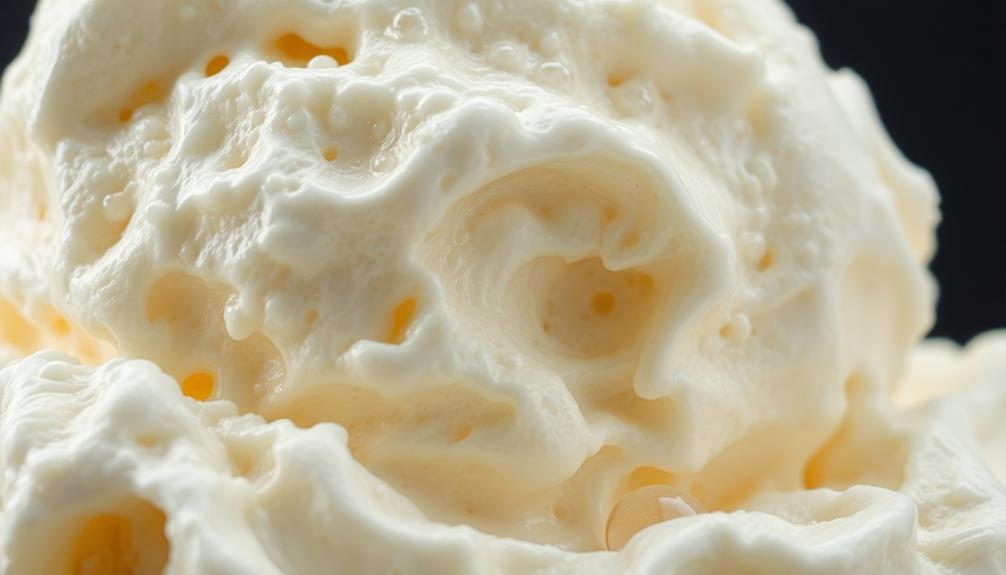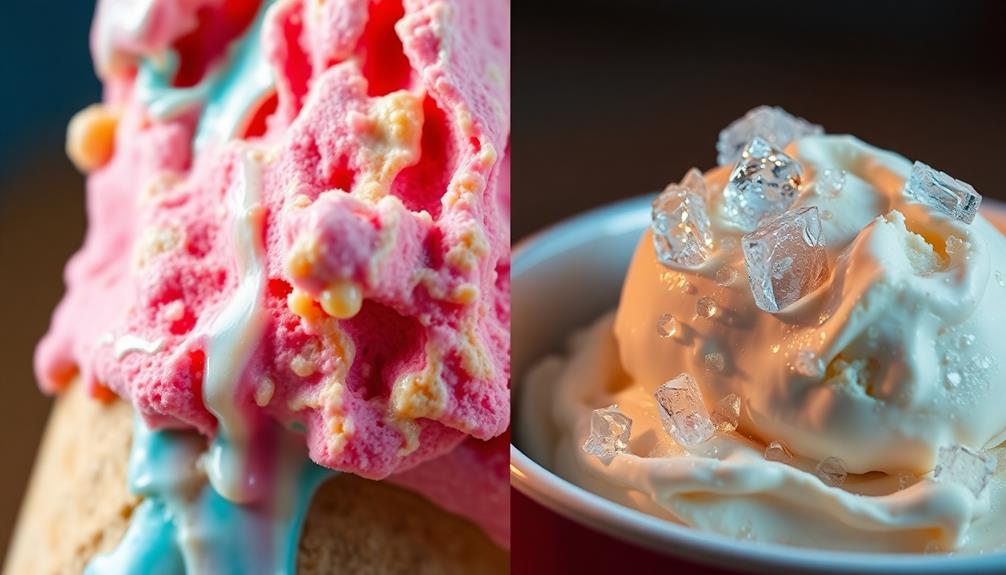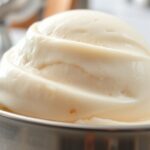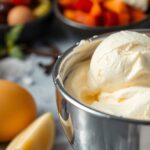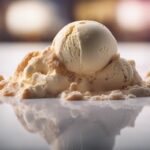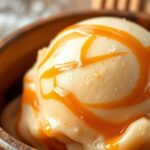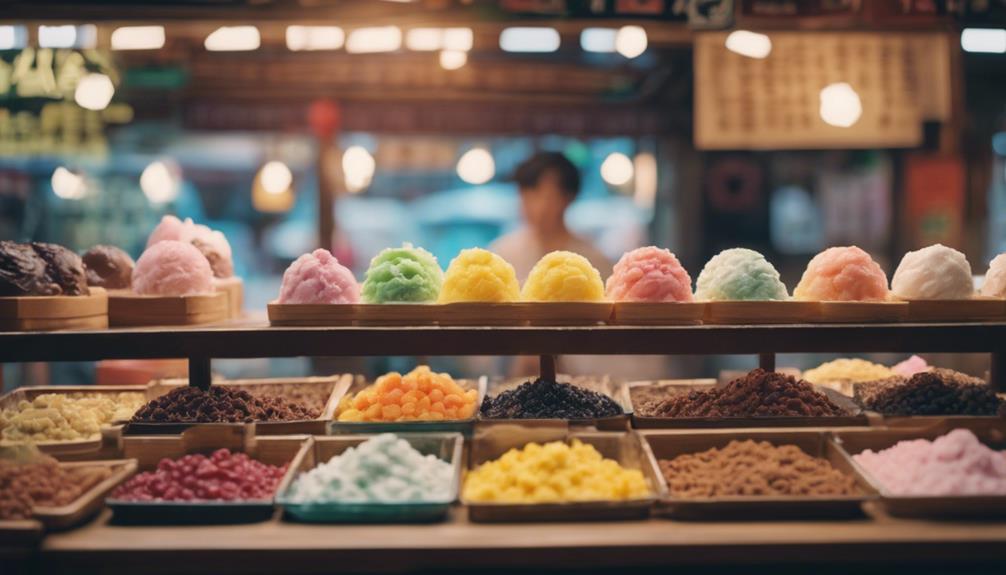The science behind ice cream's texture and mouthfeel is all about balance. You have ice crystals, fat, air, and emulsifiers working together. Smaller ice crystals create a creamy texture, while larger ones can make it grainy. The fat content, typically between 10% and 20%, adds richness, while air incorporation lightens the overall feel. Emulsifiers guarantee that fat mixes evenly, contributing to a smooth mouthfeel. Sugar helps lower the freezing point, reducing ice crystal growth. This careful interplay of ingredients results in the delightful experience you enjoy. There's so much more to uncover about how these elements interact!
Key Takeaways
- Ice cream's texture is influenced by the size of ice crystals; smaller crystals create a creamy texture, while larger crystals result in a grainy feel.
- Air incorporation (overrun) is essential for lightness; higher overrun yields a fluffier texture, while lower overrun leads to denser ice cream.
- Fat content affects creaminess; higher milk fat enhances smoothness and richness, while balanced fat prevents cloying flavors and coarse textures.
- Sugar solutions lower freezing points, reduce ice crystal formation, and create a matrix that supports the overall texture and flavor of ice cream.
- Emulsifiers stabilize fat distribution and air incorporation, ensuring a smooth mouthfeel and preventing undesirable textures from large ice crystals.
Understanding Ice Cream Composition
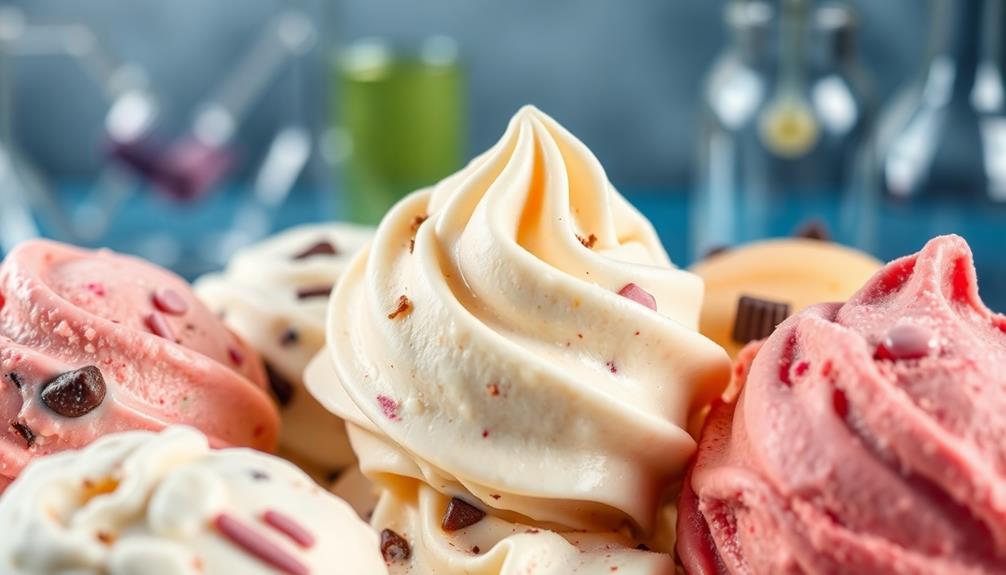
Ice cream's composition is fascinating, as it combines three states of matter: solid, liquid, and gas. This unique blend directly influences its texture and mouthfeel. The solid portion consists mainly of ice and fat, while the liquid adds a sugar solution that sweetens and alters the freezing point of water. This prevents complete freezing, reducing the formation of large ice crystals that can ruin the smoothness.
In fact, about 30% of ice cream's composition is made up of ice crystals. Smaller crystals, measuring between 10-20 µm, contribute to a velvety texture, while larger ones (greater than 50 µm) can create a grainy experience. The fat content, which typically ranges from 10% to 20% in premium varieties, enhances the richness and creaminess you associate with high-quality ice cream.
Moreover, air bubbles, incorporated during the mixing process, account for 30% to 50% of the total volume—this is known as overrun. The higher the overrun, the lighter and fluffier the texture.
Understanding these components helps you appreciate the complex science behind your favorite frozen treat!
The Role of Ice Crystals
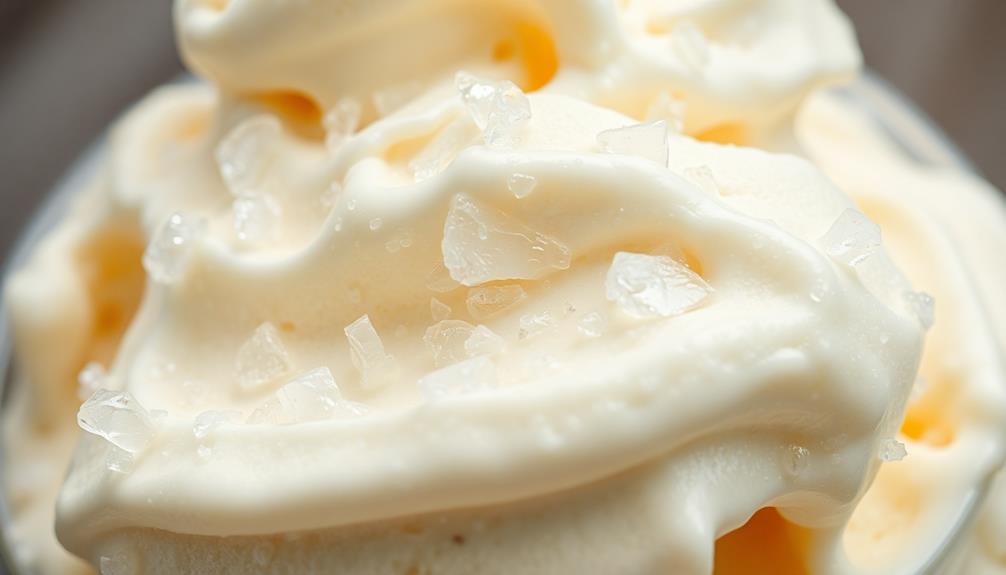
The size and distribution of ice crystals play a pivotal role in determining ice cream's overall texture and mouthfeel. These ice crystals make up about 30% of your favorite dessert, and their size directly impacts how smooth or grainy it feels.
Ideally, you want smaller ice crystals, between 10 to 20 µm, because they contribute to that creamy texture you crave. On the other hand, large ice crystals, greater than 50 µm, can lead to a grainy texture, often ruining the experience.
The freezing process is essential for ice crystal formation. Rapid freezing minimizes the growth of large ice crystals, resulting in a smoother final product.
Sugar also plays a significant role here; it lowers the freezing point of water, preventing large ice crystals from forming. Additionally, stabilizers are often added to the mixture to absorb excess water and inhibit ice crystal growth, ensuring your ice cream remains creamy over time.
Effective churning during the freezing stage helps distribute those small ice crystals evenly, enhancing the texture further. By understanding these elements, you can appreciate the science that makes ice cream so deliciously enjoyable.
Importance of Air Incorporation

When it comes to ice cream, air incorporation, or overrun, plays a key role in shaping its texture.
You'll notice that the right balance of air bubbles not only lightens the ice cream but also enhances its creaminess, making each bite more enjoyable.
Understanding how to stabilize these air bubbles during churning is essential for achieving that perfect mouthfeel.
Role of Overrun
Overrun plays an essential role in determining the texture and mouthfeel of ice cream, as it refers to the increase in volume from air incorporation. The amount of air in your ice cream considerably impacts your experience, affecting everything from creaminess to density.
Here's what you should know about overrun:
- Higher overrun (up to 100%) creates a fluffier texture, making it lighter and airier.
- Lower overrun (around 25%) results in a denser, richer product.
- Air bubbles introduced during churning help prevent large ice crystals, ensuring a smoother texture.
- Emulsifiers and proteins stabilize air bubbles, retaining them during freezing and extending shelf life.
The ideal balance of overrun enhances the overall mouthfeel. More air gives you that delightful lightness, while less air contributes to a creamy sensation.
Understanding how overrun affects ice cream can help you choose the perfect treat for your taste buds. When you savor each bite, remember that the incorporation of air is just as vital as the flavors themselves, shaping the delightful experience that's ice cream.
Air Bubble Stability
Air bubble stability significantly affects ice cream's overall texture and mouthfeel. In ice cream production, incorporating air is essential, as it enhances volume and creaminess. The relationship between overrun and air bubble stability is imperative; premium ice creams typically have an overrun of around 25%, while cheaper varieties can reach up to 100%.
When air bubbles are small and stable, they create a smooth mouthfeel. However, larger bubbles can lead to a grainy texture, diminishing the experience. Emulsifiers are key players here, as they help maintain air bubble stability by preventing coalescence, ensuring a uniform texture.
The balance between fat globules and proteins is also fundamental. Proper churning during freezing incorporates air while preserving the delicate ratio of emulsifiers and stabilizers to maintain both air bubble stability and the ice cream's smoothness.
Here's a quick overview of the factors affecting air bubble stability:
| Factor | Effect on Texture |
|---|---|
| Emulsifiers | Stabilize air bubbles |
| Fat Content | Influences smoothness |
| Protein Presence | Affects bubble stability |
| Overrun | Determines volume |
Impact of Fat Content
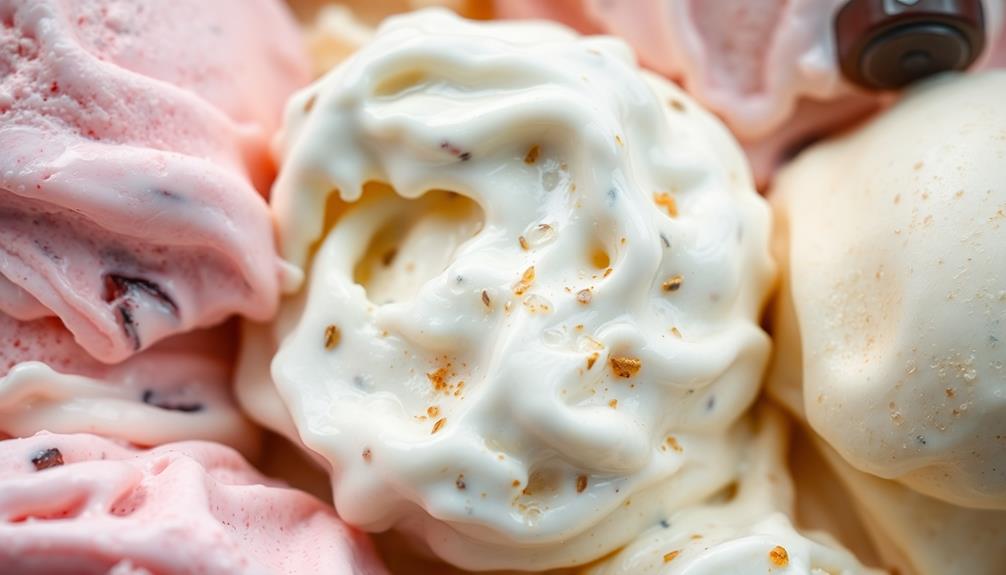
When you think about ice cream, the fat content plays a vital role in shaping its texture and mouthfeel.
Different types of fat, like milk fat and cream, affect the creaminess and consistency, while finding the right balance is key to avoiding cloying or coarse textures.
Understanding how these factors interact can help you appreciate your favorite flavors even more.
Role of Milk Fat
How does milk fat influence the overall experience of ice cream? The role of milk fat is vital in determining the ice cream texture and your enjoyment of it. Typically, milk fat makes up 10% to 20% of ice cream's composition, with higher fat content creating a richer and creamier texture.
Here are some key points to take into account:
- Stabilizes air bubbles: Fat globules help retain air, enhancing creaminess.
- Smooth mouthfeel: Proper fat crystallization guarantees a velvety texture that melts beautifully.
- Density and flavor: Higher milk fat content means lower overrun, resulting in a denser product with better flavor retention.
- Balanced experience: The ideal fat balance prevents cloying flavors or a wet, coarse texture.
When the fat is well-organized, it leads to a smooth mouthfeel, while poor fat crystallization can leave you with a gritty or icy experience.
Types of Fat
The types of fat used in ice cream greatly impact both its texture and overall mouthfeel. The fat content in ice cream typically ranges from a minimum of 10% to as high as 20% in premium ice cream, markedly contributing to its creaminess. Higher fat content promotes a smooth texture by enhancing fat organization and minimizing the presence of icy particles.
However, it's vital to find the right balance; excess fat can create a cloying flavor, while too little results in a wet, coarse texture.
Fat crystallization during the freezing process also plays a key role in the final texture. Smaller fat crystals lead to a creamy mouthfeel, whereas larger crystals can produce a gritty texture that's less enjoyable.
Emulsifiers are essential in this scenario, as they stabilize fat globules within the ice cream mixture. By preventing fat from clumping together, emulsifiers help maintain that desirable smooth texture you crave in every scoop.
Ultimately, the right combination of fats and emulsifiers guarantees you experience the rich, creamy ice cream that delights your taste buds.
Fat Balance Importance
Properly balancing fat content is essential for crafting ice cream that delights your palate. The fat percentage in ice cream typically ranges from 10% to 20%. This balance is vital because it influences not just the creaminess, but also the overall texture and mouthfeel.
Too much fat can make your ice cream cloying, while too little results in a wet and coarse experience. To achieve that perfect balance, consider the following:
- Higher fat contributes to a richer, smoother mouthfeel.
- Smaller fat globules enhance the overall texture, preventing grittiness.
- Emulsifiers stabilize the mixture, ensuring uniform distribution of fat.
- Proper fat balance aids in flavor delivery, enhancing your taste experience.
When you get the right amount of fat, it helps dissolve and carry flavor compounds, making every bite more enjoyable.
The organization of fat within your ice cream mixture is just as important; it's the key to achieving that coveted creamy texture. By carefully controlling fat content, you can create an ice cream that not only tastes fantastic but also feels indulgent on your tongue.
Significance of Sugar Solutions
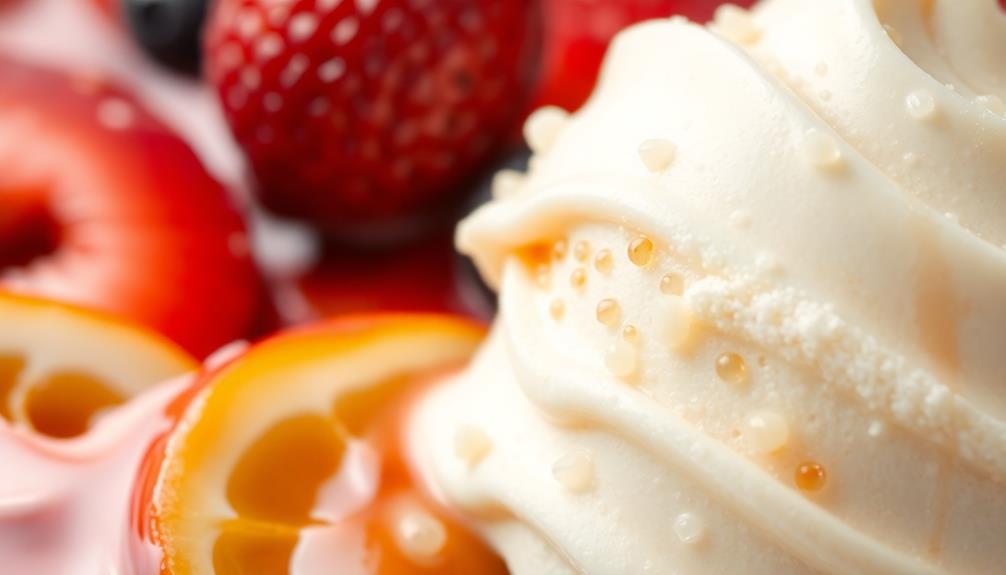
When you indulge in a scoop of ice cream, the significance of sugar solutions becomes immediately apparent. Sugar isn't just about sweetness; it plays an essential role in the overall texture and mouthfeel of the dessert. By lowering the freezing point of water, sugar prevents complete freezing, allowing for a creamy, smooth texture. This means that the ice cream remains soft and pleasant instead of turning into a solid block.
Different types of sugars, like sucrose and glucose, contribute varying levels of sweetness and body. By combining these sugars, ice cream makers fine-tune the balance between sweetness and texture, ensuring you get that delightful flavor without it being overwhelmingly sweet.
Additionally, sugar helps reduce ice crystal formation during the freezing process, leading to smaller ice crystals that enhance the smooth mouthfeel you crave.
In essence, sugar solutions create a matrix that suspends ice, air, and fat, which is essential for achieving the perfect ice cream experience.
Function of Emulsifiers
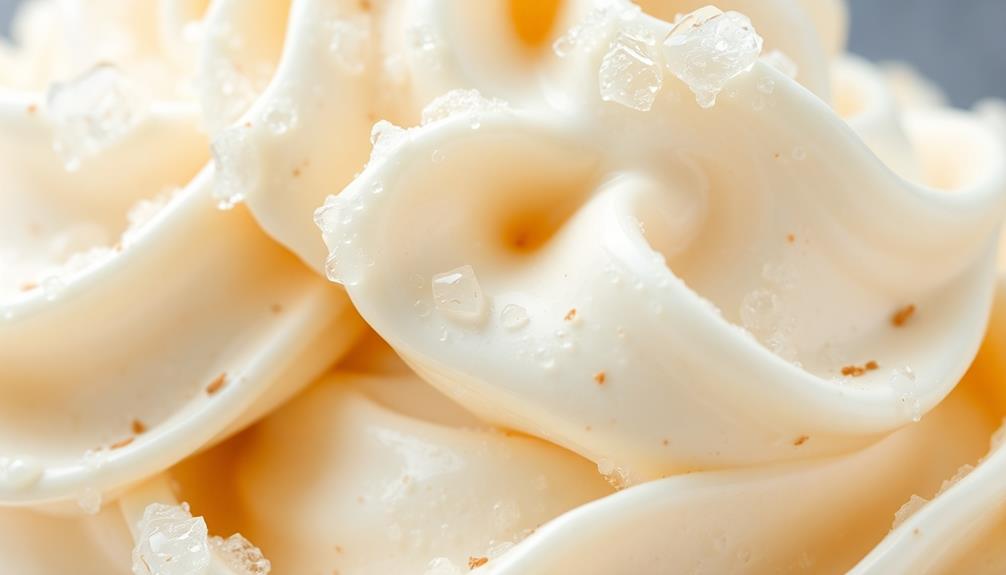
Emulsifiers play an essential role in creating the smooth, creamy texture you love in ice cream. They're important for stabilizing ice cream mixtures, preventing fat globules from clumping together, which results in a homogenous texture.
By reducing surface tension between fat and water, emulsifiers help distribute fat evenly throughout the base, enhancing creaminess and mouthfeel.
Here's how emulsifiers contribute to your favorite treat:
- Stabilizing the mixture to prevent fat coalescence
- Enhancing creaminess by evenly distributing fat
- Improving air incorporation during churning for a lighter texture
- Preventing large ice crystals that can ruin the experience
Common emulsifiers like lecithin and polysorbate 80, as well as natural options like egg yolks, not only stabilize but can also affect flavor.
It's crucial to balance the amount of emulsifiers used; too little can lead to a coarse texture and quick melting, while too much can create an unpleasant mouthfeel.
Understanding the function of emulsifiers helps guarantee that every scoop is just as delightful as the last!
The Ice Cream Production Process
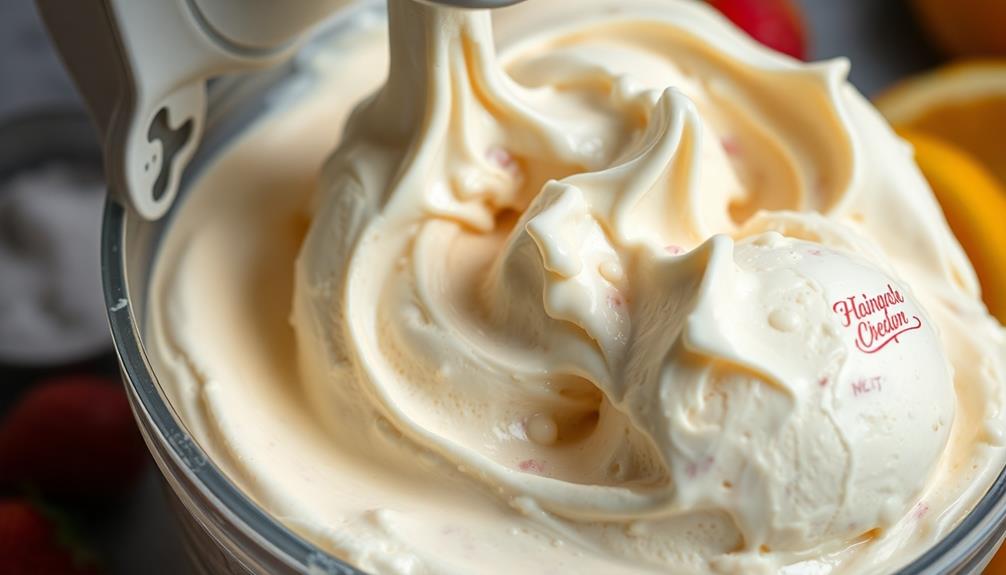
The ice cream production process involves several key stages that guarantee you get that perfect scoop every time.
First, you prepare the mix by combining ingredients at a high temperature of 85°C (185°F) for effective pasteurization. This secures safety and uniformity in the mix.
Next, you move to the aging stage, where the mix rests. This resting period enhances flavor and texture by allowing fat globules to crystallize and emulsifiers to stabilize air bubbles.
Then comes the freezing stage. Here, air is incorporated while the mixture is churned, forming small ice crystals. Rapid cooling during this stage is essential to minimize the growth of large ice crystals, which can negatively affect the smooth texture you desire.
Finally, you enter the hardening stage, where the ice cream is frozen to about -6°C. This process gives your ice cream the desired firmness and prevents further ice crystallization, securing a stable product.
Each of these stages plays an important role in creating the delightful ice cream experience you love, contributing to its creamy texture and rich flavor.
Balancing Ingredients for Texture
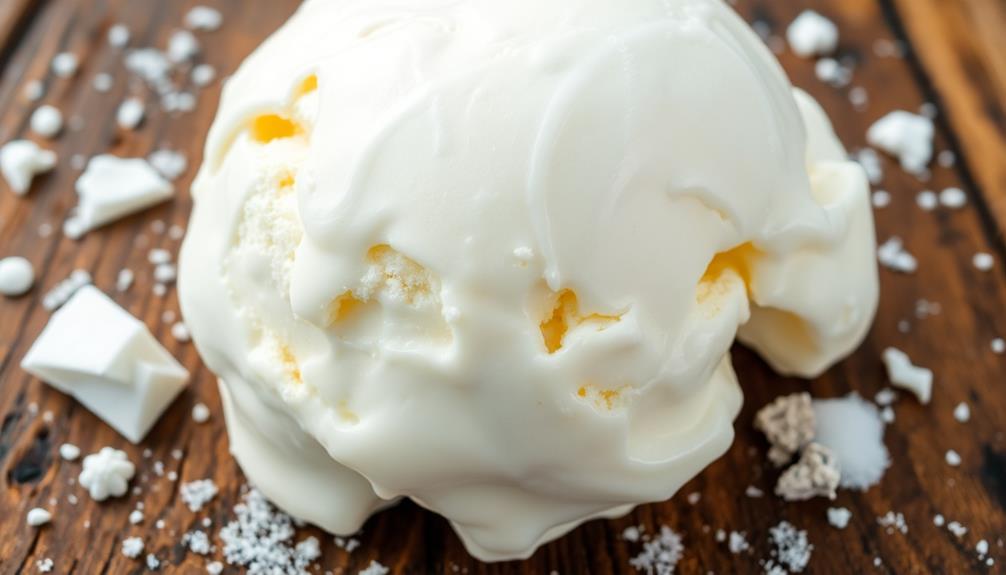
To achieve that perfect ice cream texture, balancing ingredients is key. You need to carefully manage the levels of fat, sugar, and other components to create a smooth, creamy product. Here's what to take into account:
- Fat: Aim for at least 10% fat for a rich mouthfeel; premium varieties can have up to 20%.
- Sugar: Different sugars, like sucrose and glucose, help lower freezing points and reduce ice crystal formation, enhancing sweetness.
- Emulsifiers: These prevent fat globules from clustering, ensuring a smoother texture. Common emulsifiers include lecithin and mono- and diglycerides.
- Stabilizers: Ingredients like guar gum and locust bean gum increase viscosity, preventing large ice crystals and improving mouthfeel.
Overrun, or the amount of air incorporated, also plays a crucial role in balancing density and lightness. Premium ice creams typically have around 25% overrun, while cheaper varieties may exceed 100%.
Frequently Asked Questions
How Does Ice Cream Get Its Texture?
Ice cream gets its texture through a mix of ice crystals, air, and fat. When you choose a creamier option, you're enjoying smaller ice crystals and less air, resulting in a denser, richer experience.
What Is the Science Behind Ice Cream?
Imagine a symphony of flavors blending together. The science behind ice cream involves balancing ingredients, controlling temperatures, and manipulating textures. You create creamy delights by mastering fat content, air incorporation, and ice crystal size.
How Does Air in Ice Cream Affect the Taste and Texture?
Air in ice cream affects your taste and texture by creating a smoother mouthfeel and enhancing flavor release as it melts. A balance of air bubbles contributes to creaminess, influencing your overall enjoyment of the dessert.
What Determines the Consistency of Ice Cream?
The consistency of ice cream depends on factors like ice crystal size, fat content, air incorporation, and stabilizers. Managing these elements during production guarantees you enjoy that smooth, creamy mouthfeel you love.
Conclusion
To summarize, the texture and mouthfeel of ice cream are crafted through a delicate balance of ingredients and processes. Did you know that the ideal ice cream contains about 30% air? This incorporation not only makes it lighter but also enhances the overall creaminess. By understanding how factors like fat content and sugar solutions come into play, you can appreciate every scoop even more. So next time you indulge, think about the science that makes your favorite treat so delightful!
